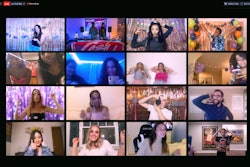
The COVID-19 pandemic has forced us to examine nearly every aspect of how we do business—and social media is no exception. Platforms such as Instagram have long been effective ways for event professionals to share their work and find new business. But with live gatherings temporarily on hold, how can companies find new content to post? Is it appropriate to get more personal? What platforms are effective now?
BizBash caught up with event professionals around the country to learn the new rules of social media.
All my events are on hold. How can I find new content to post?
“The key is to stay true to your brand and brand values,” says marketing consultant D. Channing Muller, founder of Chattanooga, Tenn.-based firm DCM Communications. “Every post doesn't have to include a call to action that says ‘Buy from me!’ for it to be promoting your business. As my college counselor taught me while writing admissions essays, ‘Show, don’t tell.’ … Use photos from past events or inspirational images that align with your brand to simply keep the conversation with your followers (and a larger audience) going during this time.”
Older photos and content can also help emphasize the importance of the face-to-face event industry. “It reminds everyone that while the art of gathering may be on pause temporarily, these moments are more important than we ever gave them credit for,” points out Christie Altendorf, senior event planner and marketing manager for D’Amico Catering in Minneapolis. (D'Amico works with Roepke Public Relations on all social media strategy and posting.)
The team at Mavinhouse Events in Ipswich, Mass., agrees. “Posting older photos allows for reflection on moments and celebrations that were particularly meaningful. Using our personal voices to walk followers through the memorable aspects of those [events] conveys a sense of hope,” says the company.
Photos and details from past events are also an effective way to highlight your favorite vendors. “We've been curating photos from our favorite creative vendors (or those we want to work with more in the future) and resharing to give them a bit of a brand boost during a time when more people—clients and colleagues—are spending more time on social media,” explains the Mavinhouse team. “Captions are used to share why that vendor is so special, and the ways we've worked together.”
Good idea. How else can I use social media to help my go-to vendors?
Credit, credit, credit! Tagging the team you worked with is always a social media best practice for event pros, and it is more crucial than ever right now as event businesses are struggling financially. Credit your photographers and videographers and make sure to tag the vendors you worked with on the pictured event.
Meanwhile, Katie Webb Brundige and Meghan Clem, co-founders of Intertwined Events, are using social media for live giveaways that highlight their small business partners. They’re also using their platforms—as well as Yelp—to recommend companies they’ve had good experiences with. “From photographers and videographers to rental companies, we’ve been showing our love and support for others in the industry by leaving thoughtful reviews,” notes the Irvine, Calif.-based duo.
How else can my social media act as a useful resource?
Beyond inspirational photos, use this time to position yourself as an expert. If your social media pages become a go-to place for resources and solutions, people will remember it when business picks up again. “The Sequence social mission over the past six weeks has been sharing trends, ideas, and solutions—regardless of whether they originated from Sequence or elsewhere,” says Adam Sloyer, CEO of Sequence Events in New York. “This is a time of need for so many, both personally and professionally, and we want our channels to be a resource to the events community at large.”
InVision Communications, an engagement solutions agency with offices in San Francisco, Chicago, and New York, is also taking a thought-leadership approach to social media right now. “We’ve shifted so that the majority of the content we share is covering topics that are pain points we know our clients are grappling with,” says Laliv Hadar, InVision's vice president of marketing. “Themes include best practices for pivoting to digital experiences, leading virtual events, and crafting communications plans to support new digital initiatives. … The key for us is tone, and ensuring that the content we provide is helpful and supportive to our clients and partners’ needs at this time.”
The Mavinhouse Events team adds: “People are looking for an escape, but also motivation to dig deeper and find new layers of creativity—particularly for event professionals.”
Should I be getting more personal than usual?
“This situation has democratized social media, dissolving the expectations we have about others and ourselves," says the Mavinhouse team. "The authenticity factor is at an all-time high. We are seeing everyone in their ‘natural habitat,’ from news anchors to celebrities on video calls. It's like peeling back a layer of expectations people have of others, and the strive for perfection in your digital image.”
Patty Speirs, the owner of Every Last Detail Wedding & Event Coordination in Salinas, Calif., agrees with that “we’re all in this together” approach. “I post videos of me being silly or working out, images of my dog, me sans makeup—it’s an attempt to share positivity and remind people that, no matter what's going on, to be grateful for something every day.”
But, cautions Muller, don’t stray too far from your original brand voice. “If you are the face of your company or brand, then by all means, keep that face present,” she says. “However, if your children do not tie into your company or company values in any way, this is not the time to have them all over the feed. In a story post or two? Sure. That’s real life, and having little ones pop on Zoom calls is a reality everyone is dealing with. But if you have never shown those sides of your life before on the business page, then I’d keep it very minimal.”
Muller adds: “There are plenty of other ways to showcase your life and work-life now, outside of being fully transparent to what your new day-to-day looks like. After all, people on the business page follow you for a reason. Keep giving it to them. Stick to your company and brand values and content pillars—with a dash of behind-the-scenes of home-schooling or pet playtime thrown in—and you’ll be good.”
When you do want to get more personal or showcase your team, do it in a way that ties back to your company’s mission. For example, D’Amico Catering recently used Instagram to highlight how 20 of its employees were celebrating the Passover and Easter holidays. “From old family recipes to new, trendy dishes, the Instagram story showed our viewers that despite the distance, great food is in the DNA of our people and a common thread that connects us all,” explains Altendorf.
How often should I post, and what platforms are the most useful right now?
Focus on quality over quantity, stresses Muller. “Do not feel you have to post on the same schedule you did when events were still part of daily life. There’s nothing more annoying at a dinner party than when someone jumps into a conversation and contributes nothing beyond the sound of their voice, right? Same is true on social media,” she says. “Either provide value to others—i.e., insights, advice, inspiration, beauty, laughter, or simply an escape for a few minutes—or hold off until you can, and just engage with others.”
As for which platforms to use, Muller notes that engagement in Instagram Stories has been up during the COVID-19 crisis, while on-page photo engagement tends to be down. “Facebook groups are seeing a huge uptick in engagement as well,” she adds. “That is the perfect place to join the discussion and keep your voice (and brand) present without being pushy. The same rules apply here: Contribute valuable information to the conversation, or just read and consider it research time."
This also may be the time to build up your less-used platforms, too. “I've been trying to utilize social media that I would normally leave on the back burner, such as LinkedIn and Twitter,” notes Madeline Raithel, who handles social media for Entire Productions, a San Francisco-based entertainment company that is using social to showcase its artists and host virtual variety shows. Meanwhile, Katherine Stinnett, sales and marketing manager for the RT Lodge in Maryville, Tenn., is spending time on Pinterest. “We’ve tried to keep a constant stream of new content on our wedding Pinterest boards for brides who are still planning their weddings," says Stinnett. "We don’t want them to feel like they aren’t allowed to be excited and hopeful for their future wedding.”
LinkedIn has also emerged as an engagement-heavy place to share resources. “From maintaining your personal brand to creating new professional relationships, LinkedIn is more relevant now than ever,” suggests the Intertwined Events team. “Even though you aren’t able to attend public events to network with others, or enjoy a weeknight happy hour to build connections, we’ve been using LinkedIn to socialize and get in touch with our business community.”
Do people even want to hear from me right now, though?
“We actually have seen an uptick in engagement, which reinforces our belief that right now people are even more interested in creative solutions and what other event pros are seeing and doing,” says Sloyer. “We are very sensitive to posting anything that might seem ‘out of touch.’”
Social is also a low-pressure way to check in and share info with clients—without bombarding their email inboxes on days they might be feeling overwhelmed. “Never has customer service been more critical, and thankfully social media provides us all with a platform to interact with our clients and audiences in both a macro and micro way,” says Altendorf. “Whether they are posts that assure followers we’re taking every measure possible to create safe environments when events return, or answering a DM from a panicked client, social media allows for connectivity on every level.”
Altendorf adds: “Sharing content that allows for people to feel like they are in the venue or experiencing an event has never been easier, and it’s incredible to see them not only responding to that, but also booking future events based on it.”
When in doubt: Ask your audience what they want to see. Megan Papageorge, CEO of Sweet Peach Planning in Long Beach, Calif., has been using Instagram Stories to ask questions and host polls. “I make a lot of decisions from what the responses are,” she says. The Intertwined Events team, meanwhile, is hosting Q&As on Instagram Live to answer questions in real time, as well as posting polls on event and design trends. “Social distancing doesn't necessarily have to result in social media distancing,” they note. “While the COVID-19 chaos continues to fill up our feeds, there are still ways that you can show up, stay connected, stay positive, and drive business.”
Are you following BizBash on social media? Let us know what kind of content you want to see on our Instagram, Facebook, LinkedIn, and Pinterest channels.



















